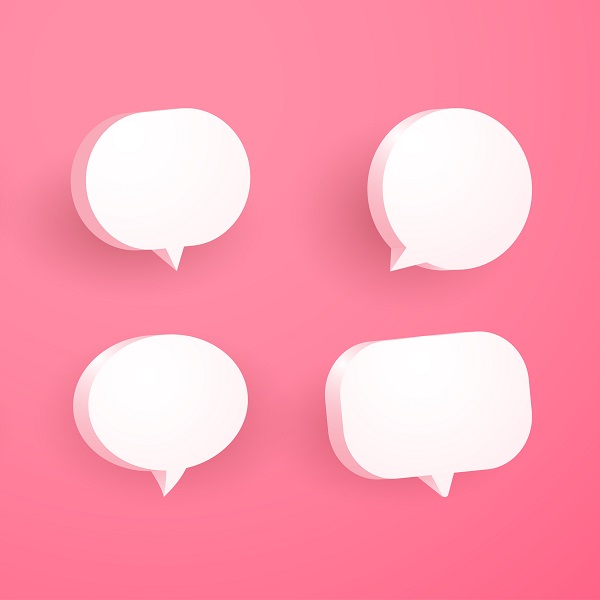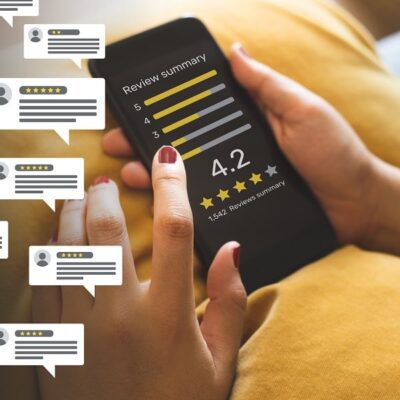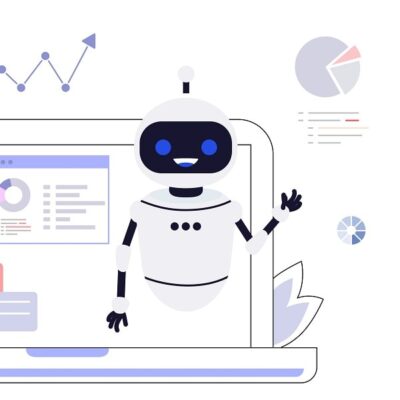This was originally published on March 14, 2018. It was last updated in August 2023.
It’s no question that AI (artificial intelligence) is changing the landscape of digital marketing, and that your marketing efforts should be changing with it. One of the most accessible forms of AI comes in the form of chatbots.
For any chatbot to work effectively, it needs to be designed with your specific customers or employees in mind. This isn’t an issue for those with coding experience, but for businesses without tech professionals on their team, a chatbot may seem out of reach.
Never fear—whatever your background, you can learn how to create a chatbot in just a few minutes with the help of a few DIY chatbot services. We will dive into what chatbots are used for, different chatbot elements to consider, and step-by-step instructions to help you create and install chatbots. Let’s start chatting!
Table of Contents
How Can I Create a Chatbot If I Have Zero Coding Experience?
How to Create a Chatbot That Doesn’t Require Code
How to Install a Chatbot with Code
What is a Chatbot Used For?
Chatbots are used to give assistance to customers who need answers to their questions online. They also connect users with the services, products, or information they may need to simulate person-to-person conversation. You can add this feature to help give assistance on your website or through other social media platforms your business may be present on.
Chatbots interpret customer’s words or phrases and process them to give an answer. They provide responses based on a combination of predefined scripts and machine learning algorithms. They are programmed to be as close to human responses as they can be.
Most of the time, chatbots are associated with customer support and customer experience to help improve UI. Setting up chatbots have been known to help optimize workflows, processes, and services for businesses who have an online presence.
Chatbot Elements to Consider
1) Structure Your Goals
The chatbot you want to create for your website has to work with the specific business requirements. So, before you build one, it is vital to outline your goals and define the needs you want from a chatbot. It’s equally important to identify the business functions and tasks that you need to be automated.
Before building a bot, you should know what AI chatbots are capable of doing and what they can’t do. You also need to know the type of chatbot problems you want solutions for. Be prepared for the pros and cons that will come from using chatbots and whether or not it’s the right decision for your website.
2) Personalization
When you create and install a chatbot, you get to customize and add your own touches to it. It also helps add a humanized touch to your bot to be more comfortable and friendly.
It’s important to consider the bot’s personality for two important reasons. One, it helps create a deeper understanding of the end objective. Second, it helps you understand how the bot will communicate through a choice of language, tone, and style. Having this set in stone will help keep chatbots more successful on your site.
3) Deciding Functions
Chatbots will start conversations when you want them to for your customers. It’s important to consider all of the different functions that you would need to decide for your chatbot. Here’s an example of a few functions you will have to consider:
- When the bot fires triggers to all your website visitors without any specific conditions.
- When new visitors come and the chatbot fires triggers only to those specific customers. You would have to decide what you would want to say such as, “How may I assist you?”
- Having a trigger for returning visitors that fires and repeats the same message or adding, “Welcome back!” to it.
- Customizing different sayings for specific customers in different locations or time zones.
- When a bot fires if they click on certain aspects of your website. Or if there’s a certain allotted amount of time until a bot fires a trigger.
There are more considerations besides these examples that your business should think about before creating or implementing chatbots.
4) Chatbot Flow
This is one of the most important things to consider with creating your chatbot. Building the conversational flow on your website is already important for UI, but it’s also important for your chatbot. It helps organize and frame your content and also the bot’s answers. You must decide and define the bot’s flow with nodes and actions.
A node is a specific scenario or a part that you want to execute the overall bot flow. It can be anything from a welcome greeting to a product overview. An action is defined as interactions that the chatbot makes with visitors. With actions you can add different elements that help define consumer behavior.
Having a clear and normal flow to your chatbot experience is crucial to its success on your website.
How Can I Create a Chatbot If I Have Zero Coding Experience?
Fairly easily, actually! As chatbots have gained popularity, so have the number of tools available to build and implement them. You don’t need to be a super-powered developer to use many of them. For instance, here are a few that anyone can use.
Templates & Tools
Chatbot tools allow you to buy chatbot templates, similar to purchasing and installing templates for your website. These resources also include links to chatbot courses, e-books, and events that can make you an expert in no time. Utilizing templates helps add an ease and some fluidity with chatbot development for the first time. Especially when you have no coding experience once so ever, having a template can be your guide in adding chatbots to your website.
Platforms to Create Chatbots
Facebook Messenger
Facebook Messenger is one of the biggest platforms to message and have conversations with individuals. But do you know how to create a chatbot on Facebook Messenger? It’s easier than it appears!
The chatbot feature is located on the Live Dashboard in Creator Studio (under the Creative Tools lab. The two biggest steps you will take to install the chatbot is to activate the chatbot and add customizations to it. For more detailed instructions, visit Facebook to learn more.
Chatfuel
Chatfuel helps you create an AI chatbot for Facebook integration. Their service allows you to make bots for Facebook Messenger responses that go beyond Facebook’s standard chat response features. If you’re not versed in coding, this could be one of the easier ways to install a chatbot without using codes.
Landbot
Landbot has a great user interface for creating chatbots to integrate with a variety of services, including Facebook, Twitter, or Slack. This is a great option for companies looking to communicate with customers on a variety of platforms, not just Facebook.
Sequel
Sequel allows you to use drag and drop features to create bots for multiple messaging apps. It allows you to build conversational personas for entertainment and media. It also includes natural language processing (NLP) web services integration through simple API nodes.
ManyChat
ManyChat is an easy-to-use two-way interactive conversation chatbot that you could implement into Instagram messages, Facebook Messenger, and SMS to help grow your brand.
Botsify
Botsify allows you to create chatbots that you can integrate with your WordPress site. These chatbots are more customizable than some of the others.
MobileMonkey
MobileMonkey is the world’s best Facebook messenger marketing platform for marketers and companies of all sizes. With MobileMonkey, you can build powerful chatbots for Facebook Messenger, Instagram messages, SMS, and web chats easily and free with no coding required.
Chatbot Terminology
If you use any of the above platforms to create your chatbot, you’ll get an easy-to-follow walkthrough. However, it is important to know some basic chatbot terms before you get started.
The first term you may come across is “block.” Each block contains one or multiple cards—another word for messages—which the chatbot delivers to users. You can include a button at the bottom of cards to present users with a URL or a phone number or allow users to open a new block.
You’ll also need to understand the different kinds of cards available to you. These options generally include a gallery card, text card, image card, and plugin card. This last option allows you to include integration options like subscribing to your blog or sending a post to a social media account.
One final term to know is quick reply. This is an extra card that gives user input instructions on how to proceed in the case that they are unsure about the next step in their customer journey.
With this knowledge, you are ready to start building your chatbot. During the process, you will have the chance to choose templates, write text cards, create other types of cards, and add buttons. This is pretty straightforward, no matter what tool you use.
How to Create a Chatbot That Doesn’t Require Code
The exact steps you need to take to create a chatbot for your website will vary according to the platform you use. However, the process tends to be very similar for all tools. As an example for what you can expect, let’s look at how you would use Botsify to build a chatbot for your website.
Once you’ve created a Botisfy account, head to your dashboard to create a new chatbot. You have two options: using a ready-made template or creating a chatbot from scratch. If you choose a template, you can choose the type (such as FAQ or customer service) or industry (like restaurant or travel agency). Then, choose “Chatbot for Website,” give the bot a name, and save it.
Next, you need to create a “story” for your chatbot — the conversation the bot will have with users. Select the chatbot you just built and head to the “Create a Story” page.
On the left, fill the dialog box with what a user might say. You can choose how you want the bot to analyze user messages: keyword match, phrase match, or entities match. On the right, input the answer from the chatbot. You can click the “Bot Sends” button to add more bot dialog boxes.
To create subsequent user dialog boxes, click the “User Says” icon. Once you’ve created all the responses you need for your story, click the “Save” button at the top of the screen.
How to Install a Chatbot with Code
If you understand code-speak and want a little extra capability with your chatbot creation, try Motion. If you are proficient with coding, Meya and GupShup are great platforms for creating integrations for Messenger, SMS text messaging, Twitter, and more.
To build a chatbot for Facebook, Google Assistant, or Amazon Alexa, among other platforms, another option is Dialogflow (previously Api.ai).
As an example, here is how you could create a chatbot for Facebook with only basic coding in Dialogflow. As well as a Facebook and Dialogflow account, you will need a PythonAnywhere account.
- Begin by creating an agent on Dialogflow.
- Find “Small Talk” in the menu bar on the left and activate it.
- Create an intent. Input a user expression, along with its variations, and a response. (The great thing about Dialogflow is that it automatically understands some system parameters, like locations and time.)
- Add a fulfillment by creating a starter JS File called index.js on your local computer file. You’ll find the code to do this here.
- Set up a Google Cloud Project. Find the steps to do so here.
- After completing all the above steps, return to Dialogflow to enable the webhook. Confirm that you are in the right agent before you click “Fulfillment.” In the “URL” field, input the httpTrigger URL you received when you deployed the function.
Building Your SEO with Boostability
There’s no reason to feel that chatbots are out of your reach due to your lack of technical skills. The range of tools available will enable you to create a chatbot that matches your brand image, provides great usability, and performs functions that will make life easier for your customers.
Research your competitors or other businesses within your industry for inspiration on how to best incorporate chatbots into your site. If you do want greater functionality than basic tools can provide you, consider taking the time to learn basic coding, or hire a professional for the task.
Chatbots won’t make the impact you need them to if your website isn’t optimized. Need help crafting and delivering a successful SEO campaign for your client’s websites? Boostability specializes in helping small businesses increase their online presence and give them a fighting chance. As the world’s #1 white-label SEO company, we help small businesses succeed online.











1 Comment
Comments are closed.